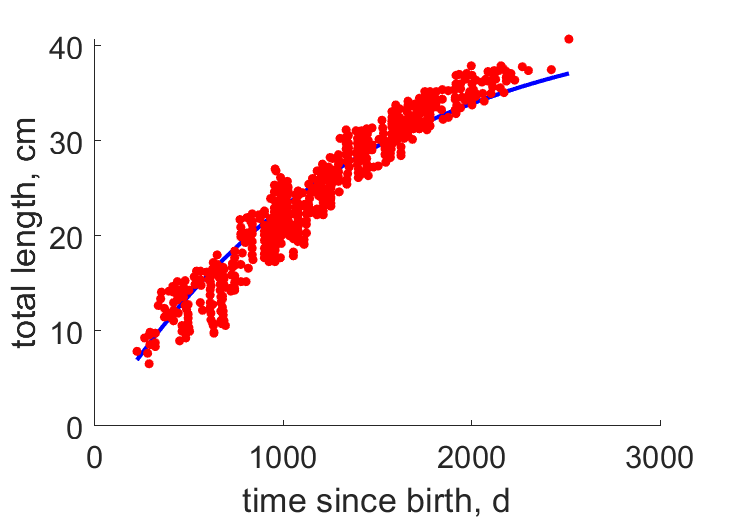Predictions & Data for this entry
| Model: abj | climate: Cfb, Dfb | migrate: Mp | phylum: |
| COMPLETE = 2.5 | ecozone: TH | food: biCi, biHl, biD | class: |
| MRE = 0.043 | habitat: 0iFp, 0iFm, 0iFl | gender: D | order: |
| SMSE = 0.004 | embryo: Fh | reprod: O | family: |
Zero-variate data
| Data | Observed | Predicted | (RE) | Unit | Description | Reference |
|---|---|---|---|---|---|---|
| ab | 2 | 2.103 | (0.05146) | d | age at birth | OrteReye2006 |
| am | 1.496e+04 | 1.497e+04 | (0.0002443) | d | life span | fishbase |
| Li | 48 | 47.68 | (0.006628) | cm | ultimate total length | fishbase |
| Wwb | 0.00052 | 0.0005023 | (0.03402) | g | wet weight at birth | guess |
| Wwp | 37.2 | 36.58 | (0.01658) | g | wet weight at puberty | OrteReye2006 |
| Wwi | 1500 | 1524 | (0.01592) | g | wet weight at birth | fishbase |
| Ri | 260.7 | 258.4 | (0.009056) | #/d | max reprod rate | OrteReye2006 |
Uni- and bivariate data
| Data | Figure | Independent variable | Dependent variable | (RE) | Reference |
|---|---|---|---|---|---|
| tL |  | time since birth | total length | (0.07656) | LoreCorb2007 |
Pseudo-data at Tref = 20°C
| Data | Generalised animal | Carassius auratus | Unit | Description |
|---|---|---|---|---|
| v | 0.02 | 0.1124 | cm/d | energy conductance |
| p_M | 18 | 17.37 | J/d.cm^3 | vol-spec som maint |
| k_J | 0.002 | 0.002 | 1/d | maturity maint rate coefficient |
| k | 0.3 | 0.6022 | - | maintenance ratio |
| kap | 0.8 | 0.9576 | - | allocation fraction to soma |
| kap_G | 0.8 | 0.8 | - | growth efficiency |
| kap_R | 0.95 | 0.95 | - | reproduction efficiency |
Discussion
- Males are assumed to differ from females by E_Hp only
- The high maintenance, compared to other family members, is probably linked to farming selection, to boost production
Facts
- length-weight: Ww in g = 0.01349*(TL in cm)^3.00 (Ref: fishbase)
Bibliography